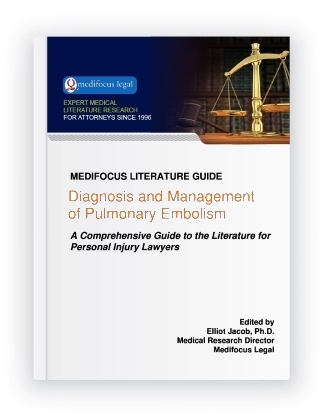Diagnosis and Management of Pulmonary EmbolismA Comprehensive Guide to the Literature for Personal Injury Lawyers
Publisher: Medifocus Legal
Publication Date: March 1, 2021
Number of Pages: 162
A Comprehensive Guide to the Literature for Personal Injury Lawyers
Publisher: Medifocus LegalPublication Date: March 1, 2021
Number of Pages: 162
The incidence of PE in the United States is estimated to be 1 case per 1,000 people per year. PE is the third most common cause of death in hospitalized patients, with at least 650,000 cases occurring annually. Autopsy studies have shown that approximately 60% of patients who died in a hospital had a PE, however, the diagnosis was missed in up to 70% of the cases. Mortality data have demonstrated that death rates from PE were up to 30% higher among men than among women. Mortality rates from PE are also about 50% higher for African-Americans that those for whites.
The key for preventing a devastating outcome in patients with suspected PE is a timely and accurate diagnosis. The classic signs and symptoms of PE include the sudden onset of chest pain, shortness of breath, and hypoxia. Unfortunately, however, most patients with PE don't have obvious symptoms at the time of presentation. Patients with PE may also exhibit atypical, nonspecific symptoms such as fainting, seizures, abdominal pain, and a productive cough. Approximately 10% of patients with PE die within the first hour, while about 30% die subsequently from a recurring embolism.
In general, the diagnosis of PE is based on physical signs of PE, a detailed hypercoagulation work-up, laboratory studies including D-dimer testing, serum troponin levels, brain natriuretic peptide, and arterial blood gases. Imaging studies that may aid in the diagnosis of PE include CT, MRI, echocardiography, venography, chest X-ray, and pulmonary angiography.
Immediate anticoagulation therapy is necessary for all patients with suspected PE or DVT. Anticoagulation therapy should not be delayed while awaiting the results of various diagnostic tests. Long-term anticoagulation therapy is typically continued to prevent the recurrence of DVT and PE. Thrombolytic therapy with agents such as alteplase or reteplase is used in patients with acute PE who have low blood pressure and who do not have a high risk for bleeding. In cases where surgery is necessary, the surgical management options include placement of vena cava filters, catheter embolectomy, or surgical embolectomy.
Because PE is a relatively common disorder that often presents with nonspecific clinical features, unfortunately, many patients die from unrecognized PE. When this occurs, the risk of litigation is elevated. Other potential medicolegal pitfalls associated with the diagnosis and management of PE include:
- Misdiagnosis of a patient's complaint of chest pain as musculoskeletal in origin without appropriate diagnostic workup.
- Attributing a patient's complaint of shortness of breath as anxiety or hyperventilation without appropriate diagnostic workup.
- Failure to initiate empirical anticoagulation therapy in a patient with suspected PE while waiting for the results of diagnostic tests such as laboratory and imaging studies.
- Failure to inform patients about major risk factors for PE including smoking, pregnancy, and oral contraceptives.
The MediFocus Literature Guide to The Diagnosis and Management of Pulmonary Embolism is a comprehensive reference guide to the medical literature that is designed to help attorneys gain an in-depth understanding of the standard of care for the diagnosis and management of this serious and potentially life-threatening condition. The Guide consists of 190 journal article references with links to the article Abstracts, including online access to the FREE full-text of 40 articles. The Guide also includes a valuable Author Directory for quickly identifying and locating experts with specialized knowledge regarding the diagnosis and treatment of PE.
 |
- A comprehensive bibliography of 190 journal article references indexed in MEDLINE published in well respected medical and scientific journals.
- Online access to the abstracts (summaries) of the articles.
- Online access to the free full-text version of 40 articles.
- Links to full-text sources of other articles that are available for purchase directly from individual journal publishers.
- A unique "Author Directory" consisting of the names and institutional affiliations of experts who have published and have specialized knowledge about Diagnosis and Management of Pulmonary Embolism. The "Author Directory" is a valuable resource for quickly identifying and locating experts for case reviews, opinions, and testimony.
Select examples of topics that are covered by the articles referenced in this Guidebook include:
- Medico-Legal Aspects of Pulmonary Thromboembolism.
- Interventional Therapies in Acute Pulmonary Embolism.
- Evaluation and Management of Intermediate and High-Risk Pulmonary Embolism.
- Deep Vein Thrombosis and Pulmonary Embolism Considerations in Orthopedic Surgery.
- Risk adapted management of acute pulmonary embolism in women.
- Diagnosis of pulmonary embolism: Following the evidence from suspicion to certainty
- Endovascular therapy for acute severe pulmonary embolism.
- Magnetic Resonance Imaging for the Evaluation of Pulmonary Embolism.
- Short- and Long-term Mortality Risk After Acute Pulmonary Embolism.
- Acute and chronic pulmonary embolism: the role of the pulmonary embolism response team.
- Pulmonary Embolism for the Cardiologist: Emphasis on Diagnosis
- Surgical Management of Acute and Chronic Pulmonary Embolism.
- Pregnancy and Pulmonary Embolism.
- Prevention of Deep Vein Thrombosis and Pulmonary Embolism in High-Risk Medical Patients.
- Pulmonary embolism: Care standards in 2018.
- Perioperative pulmonary thromboembolism: current concepts and treatment options.
- Preemptive Anticoagulation in Patients With a High Pretest Probability of Pulmonary Embolism: Are Guidelines Followed?
- Diagnosis and Exclusion of Pulmonary Embolism.
- Clinical Decision Rules for Pulmonary Embolism in Hospitalized Patients: A SystematicLiterature Review and Meta-analysis.
- The Role of Inferior Vena Cava Filters in Pulmonary Embolism.
is available in two formats: | |
Order by Phone:To order by phone, please call: Order by Mail:To order by mail, please print and complete this Order Form | |

